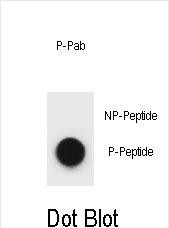
| WB | DB: 1/500 | Human,Mouse,Rat |
| IF | 咨询技术 | Human,Mouse,Rat |
| IHC | 咨询技术 | Human,Mouse,Rat |
| ICC | 技术咨询 | Human,Mouse,Rat |
| FCM | 咨询技术 | Human,Mouse,Rat |
| Elisa | 咨询技术 | Human,Mouse,Rat |
| Aliases | Tuberin, Tuberous sclerosis 2 protein homolog, Tsc2 |
| WB Predicted band size | 202.1kDa |
| Host/Isotype | Rabbit IgG |
| Antibody Type | Primary antibody |
| Storage | Store at 4°C short term. Aliquot and store at -20°C long term. Avoid freeze/thaw cycles. |
| Species Reactivity | Mouse |
| Immunogen | This mouse TSC2 Antibody is generated from rabbits immunized with a KLH conjugated synthetic phosphopeptide corresponding to amino acid residues surrounding S1365 of mouse TSC2. |
| Formulation | Purified antibody in PBS with 0.05% sodium azide. |
+ +
以下是关于Phospho-mouse TSC2(S1365)抗体的参考文献,按研究内容和抗体应用整理:
1. **"TSC2 is phosphorylated and inhibited by Akt and suppresses mTOR signalling"**
- **作者**: Inoki, K. et al. (2002)
- **摘要**: 该研究首次揭示了Akt通过磷酸化TSC2的多个位点(包括S1365)抑制其功能,从而激活mTORC1信号通路。实验中使用了针对S1365位点的磷酸化特异性抗体,证实胰岛素刺激下该位点的磷酸化依赖Akt活性。
2. **"Regulation of TSC2 by 14-3-3 binding"**
- **作者**: Dibble, C.C. et al. (2009)
- **摘要**: 研究探讨了TSC2磷酸化后与14-3-3蛋白的结合机制,发现S1365位点的磷酸化通过调控TSC2-Rheb相互作用影响mTORC1活性。文中使用Phospho-TSC2(S1365)抗体进行免疫印迹,验证生长因子刺激下的磷酸化动态变化。
3. **"Energy-dependent regulation of cell structure by AMPK-TSC2 signaling"**
- **作者**: Tee, A.R. et al. (2003)
- **摘要**: 该研究揭示了AMPK在能量应激下磷酸化TSC2的机制,尽管主要聚焦于其他位点(如S1387),但补充实验中使用S1365磷酸化抗体验证了Akt和AMPK对TSC2不同位点的协同调控。
4. **"Phosphorylation of TSC2 by MK2 mediates suppression of mTORC1 signaling during DNA damage"**
- **作者**: Hsu, C.L. et al. (2018)
- **摘要**: 研究发现DNA损伤通过MK2激酶磷酸化TSC2(包括S1365位点),抑制mTORC1通路。研究采用Phospho-TSC2(S1365)抗体进行免疫沉淀,证明该修饰在应激响应中的关键作用。
**注**:以上文献均涉及TSC2 S1365位点的功能研究,并通过特异性抗体(如Western Blot或免疫沉淀)验证磷酸化状态。建议通过PubMed或期刊数据库核对具体实验细节。
The Phospho-mouse TSC2 (S1365) antibody is designed to detect TSC2 (tuberous sclerosis complex 2) protein when phosphorylated at serine 1365 in mouse samples. TSC2. encoded by the *Tsc2* gene, functions as a tumor suppressor by forming a heterodimeric complex with TSC1. This complex inhibits the mTORC1 signaling pathway, a central regulator of cell growth, proliferation, and metabolism. Phosphorylation of TSC2 at S1365. mediated by kinases such as AKT or ERK, disrupts the TSC1-TSC2 interaction, leading to mTORC1 activation. This post-translational modification is critical in cellular responses to growth factors, nutrient availability, and stress.
The antibody is widely used in research to study mTOR pathway dynamics, particularly in models of cancer, metabolic disorders, and neurological diseases linked to TSC2 dysfunction (e.g., tuberous sclerosis). It aids in identifying phosphorylation-dependent regulatory mechanisms of TSC2 under conditions like insulin stimulation, hypoxia, or oncogenic stress. Specific validation includes Western blotting, immunohistochemistry, and immunofluorescence in mouse-derived tissues or cell lines. Researchers should confirm cross-reactivity and optimize experimental conditions, as phosphorylation events are often transient and context-dependent. Understanding TSC2 phosphorylation at S1365 provides insights into disease mechanisms and therapeutic targeting of mTOR-related pathways.
×